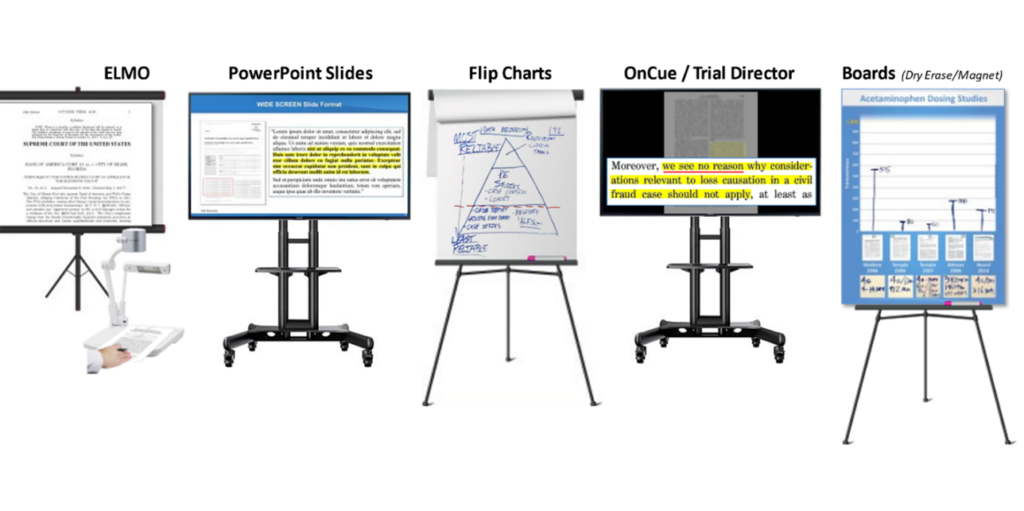Exactly How Trial Presentations Enhance Your Disagreement and Convince Jurors
Test discussions function as an essential system for improving legal debates and persuading jurors. By incorporating visual aids, narrative structures, and psychological interaction, lawyers can develop a compelling situation that reverberates on several levels. The strategic usage of visuals not only makes clear complicated details but also catches jurors' attention better than words alone. However, the art of narration plays a similarly essential function in changing factual evidence right into an engaging story, forming jurors' understandings - trial presentations. Recognizing these elements can significantly impact test outcomes, increasing the question of how each part adds to this intricate dynamic.

Significance of Aesthetic Help
Aesthetic aids play an essential role in enhancing the effectiveness of trial presentations, as they can substantially increase target market involvement and retention of details. In the context of a test, where jurors are tasked with processing complex details, aesthetic help offer to simplify and clarify bottom lines. Graphes, charts, and pictures can communicate information and concepts that might or else bewilder or confuse jurors, enabling for an extra simple understanding of the evidence presented.
In addition, aesthetic aids help in maintaining juror attention throughout the procedures. By damaging the dullness of spoken testimony, these tools can punctuate important debates, making them extra unforgettable. Efficient visual aids can additionally stimulate emotional reactions, which can be essential in persuading jurors to straighten with the presenter's story.

Crafting Engaging Stories
A compelling story is important in trial presentations, as it functions as the backbone of reliable persuasion. It permits lawyers to weave with each other truths, proof, and psychological elements into a systematic tale that resonates with jurors. This narrative structure makes it possible for jurors to comprehend the complexities of the case while guiding them with the attorney's debate.
To craft an engaging story, lawyers need to concentrate on clearness and coherence. This includes developing a clear lead character-- commonly the client-- and describing their trip via the events in question. Offering the truths in a rational sequence boosts comprehension and maintains engagement. Furthermore, making use of vibrant summaries can create psychological pictures that assist jurors imagine the events, making the story a lot more memorable.
In addition, incorporating key styles throughout the presentation reinforces the core message and help in retention - trial presentations. The narrative needs to not only share info but likewise stimulate a sense of justice, highlighting the stakes entailed. Inevitably, a well-constructed story fosters a link in between the jurors and the case, placing the attorney's debate as both credible and engaging, thereby boosting the chance of a beneficial decision

Involving the Jury Emotionally
Effective jury involvement rests on the lawyer's ability to attach with jurors on an emotional degree. This link can substantially influence jurors' assumptions and their ultimate decision-making. Making use of sob stories enables attorneys to humanize the situation, transforming abstract legal concepts into relatable experiences. By offering real-life stories or testimonies, lawyers can evoke compassion and empathy, fostering a much deeper understanding of the problems at risk. continue reading this
Visual help, such as photographs or videos, can further boost psychological engagement, providing jurors with brilliant representations of the situation's human components. Crafting a narrative that highlights the struggles and triumphs of the individuals involved makes sure that jurors see beyond the legal arguments and recognize the human consequences of their decisions.
A lawyer's enthusiastic delivery can resonate with jurors, enhancing their emotional investment in the instance. It's important to balance psychological appeals with valid proof, guaranteeing that jurors really feel forced to act while continuing to be based in the reality.
Structuring Your Presentation

The body of the discussion need to be practically segmented right into bottom lines, each supported by engaging proof. It is advantageous to utilize storytelling methods to weave realities into a story that jurors can easily comply with. Aesthetic aids, such as charts and videos, can improve understanding and engagement, helping to highlight vital pieces of proof.
Real-World Study
Checking out real-world case researches provides vital understandings right into the art of test discussions and persuasion. For circumstances, the landmark instance of "O.J. Simpson v. Individuals of The golden state" illustrates exactly how visual help and engaging stories can sway court understandings. The protection group effectively employed a technique that integrated prominent professional statements with multimedia discussions, which astounded jurors and inevitably affected their decision.
An additional notable instance is the "McDonald's Coffee Case," where the complainant's attorneys made use of graphic pictures of the injuries sustained by Stella Liebeck. trial presentations. This stark visual evidence played a critical function in sharing the extent of her burns, leading to a substantial jury honor. Such situations demonstrate that impactful trial discussions usually rest on the efficient combination of visuals and narration to stimulate emotional feedbacks from jurors
Furthermore, the "Casey Anthony Test" highlighted the importance of narrative coherence and integrity. The prosecution's failure to establish an my sources engaging timeline lessened their persuasive power, highlighting the necessity of a well-structured discussion. Examining these situations reveals that successful trial presentations call for tactical preparation, psychological engagement, and the capacity to resonate with jurors' worths and beliefs.
Verdict
Trial discussions dramatically improve debates and encourage jurors through the tactical use of aesthetic help, engaging narratives, and psychological involvement. A well-structured discussion equilibriums emotional charms with accurate evidence, inevitably reverberating with jurors' values.